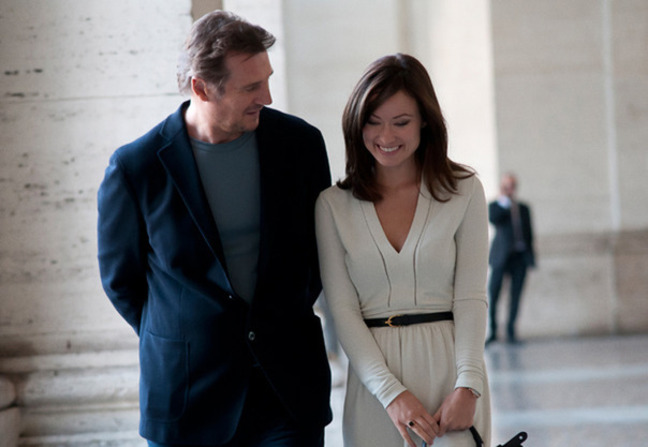Just a few more Tribeca reports to go. Here's Diana on "Third Person."

In another chapter on writer stereotypes (see also: 5 to 7), Paul Haggis’ Third Person opens on Liam Neeson’s hulking handsome frame sitting at a hotel desk, staring at his computer, with an open bottle of red wine and an ashtray heavily weighted down by burnt out cigarette ends. In the midst of the toiling and typing, he hears a child’s voice say, “Watch me.” This phrase becomes an iteration throughout the film, linking together three stories of loss and trust issues. You know how Paul Haggis likes to link (see also: Crash). To paraphrase author Michael (Neeson), all three are weak, but each have strong, albeit bordering on cliche, choices.
The most contrived storyline is that of the foreigner-wary American clothier (Adrien Brody) who falls for an attractive, mysterious, Esmeralda-type woman (Morian Atias) while on a business trip in Rome. Suckered in by her curves and quick Romanian-accented retorts, he attempts to help her get her 8 year-old daughter back from a local thug. Meanwhile, his ex-wife Theresa (Maria Bello) is back home struggling with the recent loss of their own daughter and a trying client name Julia (Mila Kunis).
 In her own complicated plot-string, the ever-frazzled Julia (frizzy hair, rubbed eyeliner) who is a socialite-turned-maid is failing to get her life back together after a messy divorce from an artist (James Franco) and her ongoing custody battle. (This is Kunis & Franco's third romantic onscreen pairing after Date Night and Oz the Great and Powerful). Given his role, James Franco gets to act out his dreams of being a finger-painting artiste. Can’t you just picture his glee while reading the part? Well, you’ll have to, because that imagined state has more emotion than Franco displays in the film. In the other corner of this divorce ring, Kunis is all emotion: longing looks for sympathy, well-placed voice cracks, frustrated laments. (2010 Oscars, anyone?)
In her own complicated plot-string, the ever-frazzled Julia (frizzy hair, rubbed eyeliner) who is a socialite-turned-maid is failing to get her life back together after a messy divorce from an artist (James Franco) and her ongoing custody battle. (This is Kunis & Franco's third romantic onscreen pairing after Date Night and Oz the Great and Powerful). Given his role, James Franco gets to act out his dreams of being a finger-painting artiste. Can’t you just picture his glee while reading the part? Well, you’ll have to, because that imagined state has more emotion than Franco displays in the film. In the other corner of this divorce ring, Kunis is all emotion: longing looks for sympathy, well-placed voice cracks, frustrated laments. (2010 Oscars, anyone?)
Acting both as the film’s center and framing device, the third (or first) plotline concerns the author, his lover (Olivia Wilde), his wife (Kim Basinger) and his book-in-progress. Out of the three stories, this is the one that could have, and should have, carried an entire film. Neeson and Wilde show real spark, spite and bite as a writing mentor and mentee meeting up in Paris (l’amour, l’amour!) -- he a Pulitzer-winning author, she a party reporter for WWD. He’s still married after losing his son in a swimming pool accident, she’s single with commitment-phobia and daddy issues. All the while, his wife is left in their marital home with little other than his recent draft to proofread for company.
Brushing aside pedantic issues and plot holes, Third Person is more a plush writer’s exercise than a multi-layered exploration of human emotions. All three plotlines are heavily concerned with the loss of children (through death, divorce, kidnapping) and questions of trust (Is the businessman being conned? Is Kunis a fit mother? Will Liam Neeson only get better with age?), but none ever reach satisfying conclusions. While the film’s intent may be a deeper understanding of humanity through a collage of struggling characters, it gets too wrapped up in the superficialities of linking them together to get to the cores of anyone involved. By the end, we are left in the emptiness of being “third person,” distanced by the inherent fourth wall (possibly placed in alignment with the central novelist) and outside the loop of whatever Haggis intended to give us as a takeaway. C-